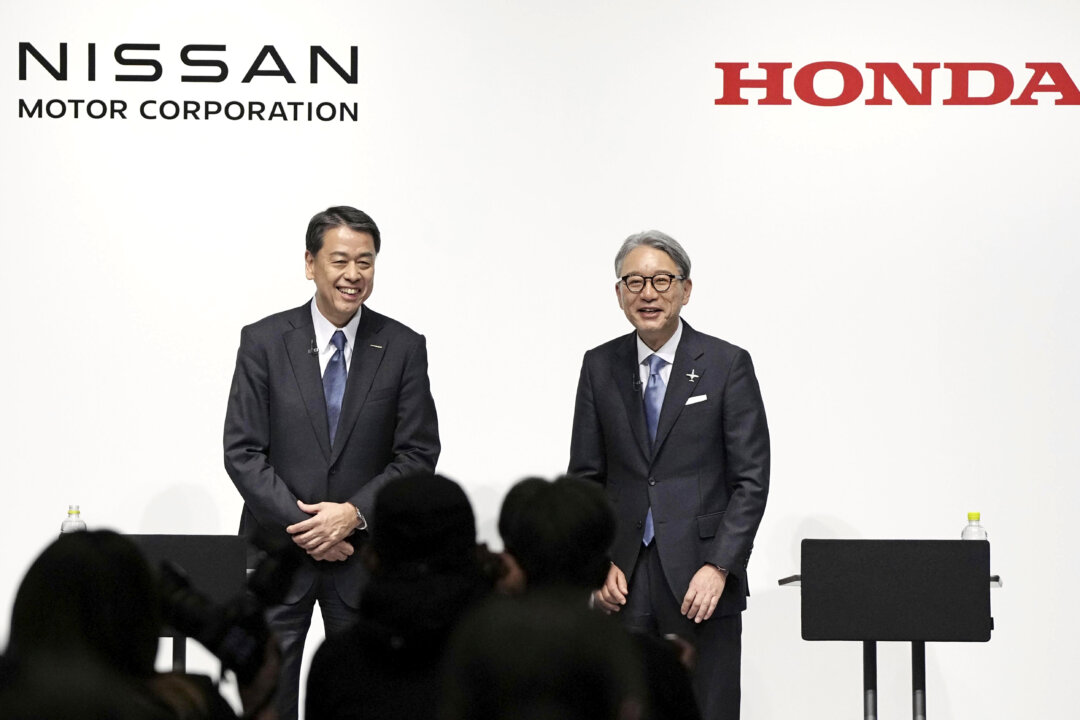If joined, the two Japanese companies would be the third-largest automaker in the world.
Nissan Motor Corp. and Honda Motor Co., two of the world’s largest automakers, could be eyeing a merger, but the companies remain tight-lipped.
On Dec. 17, Japanese newspaper Nikkei reported that Nissan and Honda were in talks to set up a holding company together.
In a translated letter distributed to shareholders on Dec. 18, Toshihiro Mibe, Honda’s director, president, and representative executive officer, said the media reports that Honda, Nissan, and Mitsubishi Motors Corp. (MMC) “will begin discussions of a business integration are not based on an announcement from the company.”
Nissan published a similar letter on the same date using nearly identical language.
“As announced in March and August of this year, the company, Nissan, and MMC combine the strengths of each company and are considering various possibilities for future collaboration, but no decisions have been made,” Mibe said in the letter. “If there are any updates, the company will inform all stakeholders at the appropriate time.”
In August, the trio of leading Japanese automakers stated that they had signed a memorandum of understanding to “jointly discuss a framework for further intelligence and electrification of automobiles.”
In August, Nissan released a statement saying the deal is focused on working together on self-driving vehicle technology, as well as jointly developing EV batteries and drivetrain components.
If Nissan and Honda were to merge, they would form the world’s third-largest automotive company by sales. That would trail only fellow Japanese giant Toyota Motor Corp. and German automaker Volkswagen Group. The deal would be bigger than the 2021 merger between Fiat Chrysler and PSA, which created Stellantis N.V.
The global push toward electric vehicles is likely a significant factor in any further cooperation between Honda and Nissan. According to figures published by Reuters, Honda wants to produce more than 2 million EVs annually and have EVs represent about 40 percent of its new car sales by 2030. Similarly, Nissan is aiming for 60 percent of its new vehicle sales to be EVs and hybrids by 2030.
While Nissan was one of the pioneers of the EV movement with its 2010 introduction of the Leaf, the Japanese automaker now trails far behind Chinese companies that make and sell most of the world’s EVs. Tesla Inc., a maker of luxury EVs, is currently selling the most EVs of any automaker in the U.S. market.
Although EVs are gaining traction in China, adoption elsewhere in the world has been slow. This is putting stress on global automakers, who are boosting their capacity to manufacture EVs but are having trouble selling them in the United States and Europe because of high prices and consumer hesitancy to abandon internal combustion engines.
Nissan is also facing financial difficulties. In November, the automaker announced that it is cutting 9,000 jobs and 20 percent of its global production capacity to reduce its annual costs by $2.6 billion.
Japanese analysts said the deal likely reflects Nissan’s weakness and both companies’ current inability to sell EVs.
“This deal appears to be more about bailing out Nissan, but Honda itself is not resting on its laurels,” said Sanshiro Fukao, an executive fellow at Itochu Research Institute in Tokyo. “Honda’s cash flow is set to deteriorate next year and its EVs haven’t been going so well. Honda itself needs to change drastically.”
Fukao went on to say the companies may not fare any better together than separately since they are already so far behind their Chinese competitors in the EV space.
“We’re no longer in the age where carmakers would join together, churn out profits through economies of scale, and then reinvest them in a five-year restructuring plan,” Fukao said. “They have no time for that.”
Tang Jin, senior principal researcher at Mizuho Bank in Tokyo, agreed with Fukao’s assessment.
“The car industry is currently undergoing rapid changes … so if the two companies cannot make decisions and execute them in unison and at speed, they may not be able to keep up with the changes,” Jin said.
Reuters contributed to this report.

